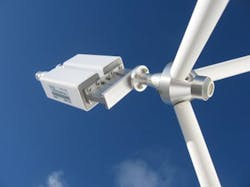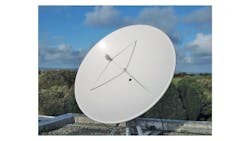Download this article as a .PDF
Satellites are being launched with greater frequency as they become more routine parts of communications network infrastructure. In addition to major systems for communications, smaller spacecraft (such as CubeSats) are being launched for research purposes, driven by initiatives from NASA. Global satellite communications (satcom) markets are projected to grow for many years.
Satellites are also used for many other non-communication-related applications (Fig. 1), including for gathering weather and geological data (such as the Landsat system), as well as providing timing and navigational information (such as the GPS systems). Still, it is their capabilities to send and receive signals beyond ground-based physical and electromagnetic (EM) obstructions that make them attractive for communications links.
While an increasing number of smaller satellites are being launched, some big birds still fly. Most recently, ViaSat announced the completion of a critical design review (CDR) milestone for its ViaSat-3 class spacecraft, now moving forward with Boeing on building, performing systems integration, and fully testing their first two ViaSat-3 satellites, powered by all-electric propulsion systems.
The ViaSat-3 satellites will be the largest satellites in the industry. Operating at Ka-band frequencies, these first two will provide coverage for the Americas and EMEA (Europe, the Middle East, and Africa), respectively, with a third ViaSat-3 satellite planned for the Asia Pacific region. The Ka-band bandwidth will enable tremendous flexibility and speed in terms of internet access and data transfers. Each satellite is expected to provide more than 1 TB/s network capability.
The beauty of communications via satellite is that a system like a ViaSat-3 can reach users wherever they are, requiring simply a ground station in the form of an antenna and transceiver—the satellite is the rest of the infrastructure. There are no copper or optical cables to run along rough terrain and no wireless base stations and antenna towers to build, with limited coverage per base station.
As with any technology, satellites have their tradeoffs, such as signal loss due to rainfall attenuation. But for areas without existing communications infrastructure (e.g., Africa), satcom technology requires an initial investment in the development and launch of an orbiting satellite, and then the network can be expanded over time with a growing number of ground stations.
Building the Parts
Satcom systems require a large number of high-frequency components, both in orbit and on the ground, in maritime terminals, and in commercial and military aviation systems that communicate by means of satellites. High-frequency components for use in satellites must be unquestionably reliable with consistent performance over long operating lifetimes, meeting the requirements for “space-qualified” components since they cannot be replaced upon failure.
Crane Aerospace & Electronics builds space-qualified passive components, including circulators and isolators, couplers, and power dividers, according to proven designs from acquired companies (such as Signal Technology and Merrimac Industries). The components are rigorously tested and have demonstrated unfailing reliability on a wide range of satellites, including Galileo, GPS, Iridium, MILSTAR, and Inmarsat satellites.
Contractors for satellite-based systems rely on space-proven components that will provide high performance levels over a long operating lifetime. In some cases, such as the defense-based satellite systems developed by General Dynamics Mission Systems, components are built according to a large library of modeled and constructed components, with physical dimensions and mechanical tolerances of waveguide components carefully controlled for repeatable, predictable performance.
Waveguide is essential for satcom components, due to its durability and low loss at higher frequencies. As satellite systems move towards Ka-band and higher frequencies, waveguide interconnections and components help to preserve the signal power at those frequencies by combining low insertion loss with low return loss (low VSWRs) for reflectionless interconnections.
Because of the rigorous testing required to ensure “space-qualified” performance levels, many suppliers of RF/microwave components for satcom applications are well-established companies with lengthy track records of having supplied various components. ARRA, for example, is a long-time supplier of waveguide bends and other waveguide components for space applications, with the machine shops and expertise to maintain the tight physical tolerances required for matched amplitude and phase performance within different satcom bands.
Several long-time satcom component suppliers are now under the L3 company banner as L3 Narda-MITEQ and L3 Narda-ATM Microwave. As with many other areas of high-frequency electronics, satcom equipment is being designed for increased functionality in smaller packages.
A long-time leader in components for satcom applications, L3 Narda-MITEQ, for example, has developed a patented line of space-saving satcom products in one-third-rack configurations, including amplifiers, frequency upconverters and downconverters, frequency translators, frequency synthesizers, and receivers, with the same performance and functionality as the full-rack-size units.
L3 Narda-ATM Microwave, which supplies a variety of coaxial and waveguide components, is well aware of the growing need for satellite components at Ka-band frequencies: 27.5 to 31.0 GHz for the uplink and 18.3 to 20.2 GHz for the downlink. The firm’s component lines include power dividers, attenuators, phase shifters, couplers, and terminations, both space-qualified versions and those for ground-station use.
In support of growing needs for antennas for Ka-band satcom links, Elite Antennas (www.elite-antennas.com) has developed an extensive line of antenna feeds (Fig. 2) and parabolic reflectors (Fig. 3) with diameters from 0.9 to 4.5 m diameter for the 17-to-22-GHz receive band. The antennas are available with circular or linear polarization. The company also supplies a wide range of antennas for commercial and military use, including a 600-mm-diameter reflector antenna with SMA connector for broadband coverage from 7.5 to 18.0 GHz, for signal intelligence (SIGINT) applications as well as for test purposes with a spectrum analyzer.
As markets for RF/microwave satcom components become more competitive, pressures force component manufacturers to find ways to provide outstanding performance at lower prices. Even smaller suppliers such as Princeton Microwave Technology must adjust to the pricing pressures and they have responded with competitive amplifier lines, including power amplifiers (PAs) and low-noise amplifiers (LNAs).
For example, a compact X-band LNA developed for 10.9 to 11.7 GHz measures 1.5 × 1.5 × 2.4 in. with WR-75 waveguide input and SMA output connector. It provides 45-dB small-signal gain with +15-dBm output power at 1-dB compression across the frequency range. It features low noise levels, with typical noise figure of 1 dB or less and spurious levels of −80 dBc. In addition to LNAs and power amplifiers for satcom use, the firm also produces lines of passive components, including power dividers, couplers, filters, frequency mixers, bias tees, and DC blocks.
As satcom markets expand, additional component manufacturers are expected to support these markets with active and passive RF/microwave components, both for broadband, multiple-purpose use and targeted for specific satellite frequency bands. This report has provides a brief sampling of suppliers. Interested specifiers are invited to visit Source ESB for more complete listings of satcom component suppliers.



